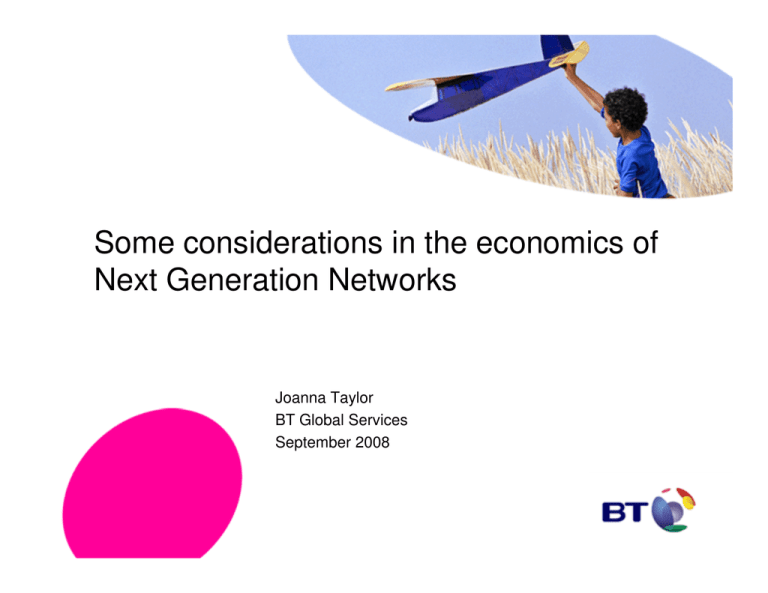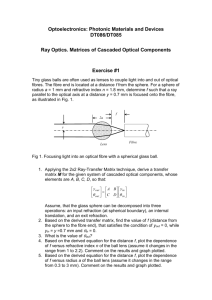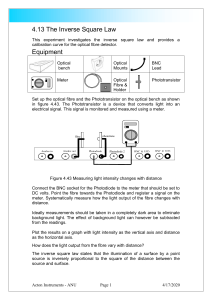Some considerations in the economics of Next Generation Networks Joanna Taylor
advertisement

Some considerations in the economics of Next Generation Networks Joanna Taylor BT Global Services September 2008 Disclaimer The comments in this presentation in relation to Next Generation Networks (“NGNs) and Next Generation Access (“NGA”), their costs and pricing, risks and rewards are generic and should not be taken as referring to any particular NGN, NGA or operator. Some considerations in the economics of Next Generation Networks • What is NGN? • Why does NGN and NGA investment raise new financial questions ? • More than one infrastructure? • Where to invest in Networks? • The cost of capital • HCA v CCA for a new network • Some thoughts on cost orientation • Unit cost profiles • Concluding suggestions What is NGN? • Next Generation Networks – IP based, highly technical network cores underpinning multiple services may initially duplicate but over time replace multiple existing networks – In the UK BT is rolling out an all IP network infrastructure (21CN) that will, in due course, replace its other networks driven by commercial need for cost reductions, faster product development times and improved customer responsiveness • Next Generation Access (NGA) – Fibre moves closer to the customer But still a role for copper – Fibre to the premises (FTTP) v Fibre to the cabinet (FTTC) Choice will depend on depend on demand, balancing cost v speed • Next Generation Services – Will come, but not clear what the services will be Wholesale and Retail markets – Data explosion predicted Why does NGN investment raise new financial questions ? • Major changes in networks and services – Investments are significant – Leading to major shift in costs between “old” and “new” assets /services – Changes in capital expenditure and operating costs • SMP operators – Have obligations around regulatory /competition pricing Cost orientation Cost accounting – Need reasonable certainty on recovery of investment • Other operators – Need certainty around their business case Products they can support Stranded assets / technologies • NRAs face major challenges Where to invest in network? • Competition in telecommunications networks has developed from the core outwards – Shared network at core v dedicated network at the edge – Highest traffic densities in core gives maximum sharing of common costs • Lowers unit cost – Reduces risk • Customer line is 100% linked to single customer so lose customer and lose ability to return on investment COPPER COPPER LOOPS Local Exchange Cabinet T M D 9 3 0 8 0 3 .D R W OPTICAL FIBRE Core Core network network Today NGA changes the cost base COPPER COPPER LOOPS Local Exchange Cabinet OPTICAL FIBRE Core Core network network T M D 9 3 0 8 0 3 .D R W Openreach consultation COPPER LOOP OPTICAL FIBRE Cabinet Local Exchange OPTICAL FIBRE Core Core network network Local Exchange OPTICAL FIBRE Core Core network network COPPER T M D 9 3 0 8 0 3 .D R W NGA FTTC replacement COPPER LOOP OPTICAL FIBRE Cabinet T M D 9 3 0 8 0 3 .D R W Where to invest in network? • Unbundled loops (LLU) has moved some investment towards to customers, • Put CP equipment in local exchanges • Backhaul from local exchange may be based in incumbent network • Needs reasonable density of customers per exchange Varies by topology and network design • Business customer densities are lower than consumer in most locations • Bitstream remains the economically rational access product for a CP in a business market COPPER COPPER LOOPS Local Exchange Cabinet T M D 9 3 0 8 0 3 .D R W LLU per customer OPTICAL FIBRE Core Core network network Shared backhaul per CP Bitstream per customer but uses incumbent’s backhaul on shared basis More than one infrastructure? • NRAs are keen on competing infrastructures – But investment must be rationale and build on sound economic business case • Fibre investments are expensive – FTTC moves the shared infrastructure closer to the customer – Increases the common costs COPPER LOOP OPTICAL FIBRE Cabinet Local Exchange OPTICAL FIBRE Core Core network network T M D 9 3 0 8 0 3 .D R W • Passive access products (e.g. duct sharing) are too far up the ladder of investment – Additional cost and lower density of customers – Market entry will not be feasible, even for CPs who have already invested to the local exchange Models suggest even in highest densities need 50%+ of customers on cabinet • Active access products provided on an equivalent basis will allow: – One NGA: improves the economies of scale for the benefit of all. Cost of capital • Investment should be rewarded – And the costs of fibre roll out, especially in access are high – Need degree of certainty of reward • But how risky is this investment? – Does the equity risk premium change significantly? – Is the technology scalable? – Is demand proven? – Does capital borrowing increase? Is the driver cost savings and increased competitiveness? What does it do to the cost and capex envelope over time? • Should the risk be rewarded by a regulatory holiday? – No – Open access gives greater potential demand and hence a lower risk So other CP traffic on this network lowers risk There is no economic rationale for multiple NGAs so need regulation Recovering costs • Traditional networks – Add the cost of capital to the operating costs of an asset – Assess the usage of that asset by services – Calculate the unit usage and the unit cost of that element – Combine with other cost items to give unit cost of service – Adjust for time of day? • Price is cost orientated • NGN and NGA – No fundamental change at the highest level But changes to assets and costs being reviewed New models required – Greater level of common costs as infrastructure is shared to a greater degree Allocation keys? Ramsey pricing? – In an IP world are all packets equal? reflect value of guaranteed bandwidth e.g. QOS? Do we have an agreed standard? HCA v CCA • CCA is a proxy for replacement costs – For traditional networks can obtain a reasonable current cost valuation Puts all operators on an equal footing Removes a distortion in the buy v build Consider Modern Equivalent Asset (MEA) Consider remaining life / depreciation • Next generation assets will need HCA to CCA and MEA adjustments – Timing will depend on the cost trend and technological changes – NGN is not a direct replacement for existing technologies Services will differ as functionality will differ So do not try and MEA the old asset with new costs • The key issue arises during the transition period – MEA recognises that technology changes The lorry is not a direct replacement of the horse and cart Some thoughts on cost orientation • Need to avoid “shocks” in end markets – Confusing message to market – Confusing message to customers – Step changes in wholesale prices are not desirable • Need to recognise that the large-scale changes move us away from a steady state – Assets and services will be different – Costs and cost drivers will be different • So over what time period do we measure cost? – Mature products over 12 months – Newer products over a longer period e.g. a life cycle – “Last-off” and “first on” distortions to unit and average costs • And what will the services be? – Probably in the same markets Unit Cost profiles Unit Cost Old steady state New steady state cost Old network New network Maximum unit cost on each network during transition Time Concluding suggestions • Operators need certainty around – their business case – products they can support • demand led – stranded assets • NRAs need to engage with industry – with a sound understanding of the CP and incumbent business models – goal of sustainable competition • Need public debate and agreement soon – or it may stifle investment by incumbents and entrants THANK YOU ANY QUESTIONS?






